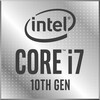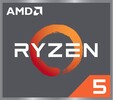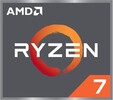Intel Core i7-10710U vs AMD Ryzen 5 3580U vs AMD Ryzen 7 3700U
Intel Core i7-10710U
► remove from comparison
The Intel Core i7-10710U is a power efficient hexa-core SoC for notebooks based on the Comet Lake (CML-U) generation and was announced in August 2019. Compared to the similar Whiskey Lake processors (e.g. Core i5-8665U), the only difference is support for higher memory speeds (DDR4-2666 vs 2400) and two additional cores in the top model. The processor cores are clocked between 1.1 and 4.7 GHz (all 6 cores 3.9 GHz max). Thanks to HyperThreading 12 threads can be used. More information on Comet Lake and all the models and articles on it can be found here.
Thanks to the two additional cores and the high clock rates, the processor performance of the i7-10710U is very good for its class. It should outperform the top Whiskey Lake and also Ice Lake processors if the cooling and TDP settings are not limiting.
The integrated graphics card however is still the same as in the previous generations. It should be still called Intel HD Graphics 620 and clock from 300 - 1150 MHz in the i7. Furthermore, the SoC integrates a VP9 and H.265 de- and encoder and an integrated dual channel DDR4-2666 / LPDDR4x 2933 / LPDDR3-2133 memory controller.
The chip is still produced on the 14nm++ process as Whiskey Lake. The TDP (PL1) is specified at 15 Watts but can be varied from 12.5 to 25 Watt from the manufacturer (cTDP up/down) resulting in different performance (especially Turbo durations). To provide the full performance, Intel proposes a short power peak of 90 W (PL4) for the i7 and therefore 8 W more than the quad-core CML-U CPUs and a whopping 19 W more than Whiskey Lake. Therefore, some slim laptops with 15W CML-U CPUs wont offer the i7 as they cant provide enough power and cooling to get full performance out of the 6 cores.
AMD Ryzen 5 3580U
► remove from comparison
The AMD Ryzen 5 3580U, a Microsoft Surface Edition chip, is a mobile SoC that was announced in October 2019 as part of the Surface Book 15. It combines four Zen+ cores (8 threads) clocked at 2.2 - 3.8 GHz with a Radeon RX Vega 9 graphics adapter with 9 CUs (576 Shaders) clocked at up to 1300 MHz. Compared to the similar Ryzen 5 3500U, the 3580 integrates a faster GPU with 9 instead of 8 CUs.
The Picasso SoCs use the Zen+ microarchitecture with slight improvements that should lead to a 3% IPS (performance per clock) improvements. Furthermore, the 12nm process allows higher clock rates at similar power consumptions.
The integrated dual-channel memory controller supports up to DDR4-2400 memory. As the features of the Picasso APUs are the same compared to the Raven Ridge predecessors, we point to our Raven Ridge launch article.
Performance
The average 3580U in our extensive database is in the same league as the Core i5-1035G7 and also the Core i7-10510U, as far as multi-thread benchmark scores are concerned. This is a fairly decent result, as of mid 2021.
Power consumption
This Ryzen 5 has a default TDP (also known as the long-term power limit) of 15 W, a value that laptop manufacturers - or should we say, Microsoft - are allowed to change to anything between 12 W and 35 W with clock speeds and performance changing correspondingly. Those values are not low enough to allow for fan-free designs, for better or worse.
The CPU is built with a fairly old, as of late 2022, 12 nm process for lower-than-average energy efficiency.
AMD Ryzen 7 3700U
► remove from comparison
The AMD Ryzen 7 3700U is a mobile SoC that was announced in January 2019. It combines four Zen+ cores (8 threads) clocked at 2.3 GHz to 4 GHz with a Radeon RX Vega 10 graphics adapter with 10 CUs (640 shaders) clocked at up to 1,400 MHz. Specified at 15 Watt TDP, the SoC is intended for thin mid-range laptops. In Chromebooks, AMD calles the APU AMD Ryzen 7 3700C, but with the exact same specifications (and performance).
The Picasso SoCs use the Zen+ microarchitecture with slight improvements that should lead to a 3% IPC (performance per clock) improvements.
The integrated dual-channel memory controller supports up to DDR4-2400 memory. As the features of the Picasso APUs are the same compared to the Raven Ridge predecessors, we point to our Raven Ridge launch article.
Performance
The average 3700U in our database is a solid mid-range CPU as of early 2021, its multi-thread benchmark scores matching those of the Core i5-10310U and the Core i5-1035G7 (the Ryzen 5 PRO 3500U is found close nearby as well). This Ryzen 7 is good for more than just binge-watching Netflix and writing e-mails. Just do not expect it to be as fast as a Core i7-11800H.
Thanks to its decent cooling solution and sufficiently high CPU power limits, the ThinkPad E595 is among the fastest laptops powered by the 3700U that we know of. It can be up to 50% faster in CPU-bound workloads than the slowest system featuring the same chip in our database, as of August 2023.
Power consumption
This Ryzen 7 series chip has a default TDP of 15 W (also known as the long-term power limit). This can be changed by a laptop manufacturer to anything between 12 W and 35 W with clock speeds and performance changing accordingly as a result. Either way, that's a little too high to allow for passively cooled designs.
Last but not the least, the Ryzen 7 3700U is manufactured on a 12 nm process for lower-than-average, as of mid-2023, energy efficiency.
| Model | Intel Core i7-10710U | AMD Ryzen 5 3580U | AMD Ryzen 7 3700U | ||||||||||||||||||||||||||||||||||||||||||||||||||||||||||||||||||||||||||||||||||||||||
| Codename | Comet Lake-U | Picasso-U (Zen+) | Picasso-U (Zen+) | ||||||||||||||||||||||||||||||||||||||||||||||||||||||||||||||||||||||||||||||||||||||||
| Series | Intel Comet Lake | AMD Picasso (Ryzen 3000 APU) | AMD Picasso (Ryzen 3000 APU) | ||||||||||||||||||||||||||||||||||||||||||||||||||||||||||||||||||||||||||||||||||||||||
| Series: Picasso (Ryzen 3000 APU) Picasso-U (Zen+) |
|
|
| ||||||||||||||||||||||||||||||||||||||||||||||||||||||||||||||||||||||||||||||||||||||||
| Clock | 1100 - 4700 MHz | 2100 - 3700 MHz | 2300 - 4000 MHz | ||||||||||||||||||||||||||||||||||||||||||||||||||||||||||||||||||||||||||||||||||||||||
| L1 Cache | 256 KB | 384 KB | 384 KB | ||||||||||||||||||||||||||||||||||||||||||||||||||||||||||||||||||||||||||||||||||||||||
| L2 Cache | 1 MB | 2 MB | 2 MB | ||||||||||||||||||||||||||||||||||||||||||||||||||||||||||||||||||||||||||||||||||||||||
| L3 Cache | 12 MB | 4 MB | 4 MB | ||||||||||||||||||||||||||||||||||||||||||||||||||||||||||||||||||||||||||||||||||||||||
| Cores / Threads | 6 / 12 | 4 / 8 | 4 / 8 | ||||||||||||||||||||||||||||||||||||||||||||||||||||||||||||||||||||||||||||||||||||||||
| TDP | 15 Watt | 15 Watt | 15 Watt | ||||||||||||||||||||||||||||||||||||||||||||||||||||||||||||||||||||||||||||||||||||||||
| Technology | 14 nm | 12 nm | 12 nm | ||||||||||||||||||||||||||||||||||||||||||||||||||||||||||||||||||||||||||||||||||||||||
| max. Temp. | 100 °C | 105 °C | 105 °C | ||||||||||||||||||||||||||||||||||||||||||||||||||||||||||||||||||||||||||||||||||||||||
| Socket | BGA1528 | FP5 | FP5 | ||||||||||||||||||||||||||||||||||||||||||||||||||||||||||||||||||||||||||||||||||||||||
| Features | LPDDR3-2133/DDR4-2666/LPDDR4-2933 RAM, PCIe 3, 4 GT/s bus, MMX, SSE, SSE2, SSE3, SSSE3, SSE4.1, SSE4.2, AVX, AVX2, BMI2, ABM, FMA, ADX, VMX, SMEP, SMAP, MPX, EIST, TM1, TM2, HT, Turbo, SST, AES-NI, RDRAND, RDSEED, SGX | DDR4-2400 RAM, PCIe 3, MMX (+), SSE, SSE2, SSE3, SSSE3, SSE4.1, SSE4.2, SSE4A, AES, AVX, AVX2, FMA3, SHA | DDR4-2400, PCIe 3, MMX, SSE, SSE2, SSE3, SSSE3, SSE4A, SSE4.1, SSE4.2, AVX, AVX2, BMI2, ABM, FMA, ADX, SMEP, SMAP, SMT, CPB, AES-NI, RDRAND, RDSEED, SHA, SME | ||||||||||||||||||||||||||||||||||||||||||||||||||||||||||||||||||||||||||||||||||||||||
| iGPU | Intel UHD Graphics 620 (300 - 1150 MHz) | AMD Radeon RX Vega 9 ( - 1300 MHz) | AMD Radeon RX Vega 10 ( - 1400 MHz) | ||||||||||||||||||||||||||||||||||||||||||||||||||||||||||||||||||||||||||||||||||||||||
| Architecture | x86 | x86 | x86 | ||||||||||||||||||||||||||||||||||||||||||||||||||||||||||||||||||||||||||||||||||||||||
| Announced | |||||||||||||||||||||||||||||||||||||||||||||||||||||||||||||||||||||||||||||||||||||||||||
| Manufacturer | ark.intel.com | www.amd.com | www.amd.com | ||||||||||||||||||||||||||||||||||||||||||||||||||||||||||||||||||||||||||||||||||||||||
| Transistors | 4500 Million | 4500 Million |
Benchmarks
Average Benchmarks Intel Core i7-10710U → 100% n=35
Average Benchmarks AMD Ryzen 5 3580U → 69% n=35
Average Benchmarks AMD Ryzen 7 3700U → 59% n=35
* Smaller numbers mean a higher performance
1 This benchmark is not used for the average calculation













